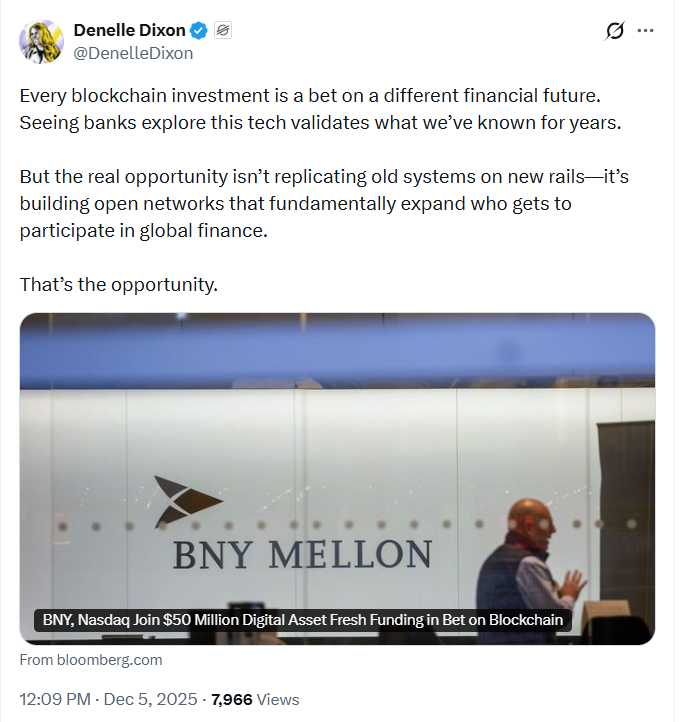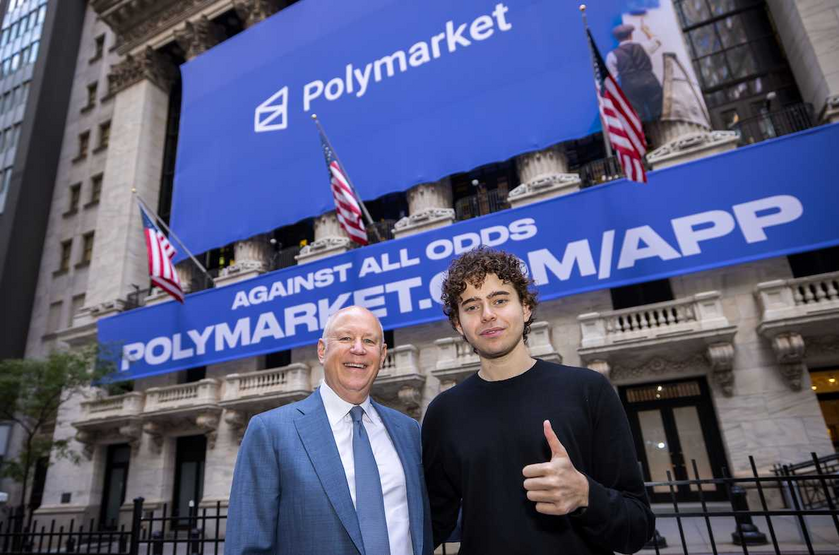Listen to This Article
)
“It’s definitely an economy that is doing very well and growth is fairly domestically driven,” said Jacobs, who added the fund likes and owns India’s bonds.


Listen to This Article
)
“It’s definitely an economy that is doing very well and growth is fairly domestically driven,” said Jacobs, who added the fund likes and owns India’s bonds.
Jack McDonald, Co-Founder of PolySign alongside Arthur Britto Timestamps for the Video listed below
Timestamps:
0:50 — Founded PolySign with Arthur Britto.
0:57 — Founding of Standard Custody.
1:01 — Ripple acquires Standard Custody.
1:20 — Why Ripple entered stablecoins and custody
1:40 — Discussion regarding Ripple and USDC
2:40 — Acquisition of prime broker Hidden Road.
3:12 — Hidden Road’s client base
4:15 — Ripple pledges $25 million
4:46 — Forward-looking commentary
OP: @ProfRipplEffect
"Ever notice how you don't actually own anything anymore? Your music 🎶, your movies 🎬, your cloud storage ☁—all of it is just a subscription 💳."
"You think you have things, but you only have access to things 🔑."
"Your identity lives inside a digital system 💻 you have no control over, and it can be flagged 🚩, restricted 🚫, or revoked automatically with no warning 🚨."
"In this society, you don't have freedom anymore. You just access it as long as the system recognises you 👀."
"Welcome to neo-feudalism—a world where your entire life is one system update away from disappearing 👻."
This is a live prototype for an alternative to the US dollar in international trade.
What Is It?
A digital currency for trade between BRICS nations (Brazil, Russia, India, China, South Africa).
It's backed by a basket of their local currencies and physical gold. How It Works (Simplified):
1⃣ Step 1: The "Basket" is Created. A "Unit Reserve Basket" holds: 40% in physical gold (40 grams for the first test batch). 60% in five BRICS currencies (12% each: Real, Yuan, Rupee, Ruble, Rand).
2⃣ Step 2: Units Are Issued. On October 31, 2025, 100 Units were created. Each Unit was worth exactly 1 gram of gold.
3⃣ Step 3: Value Fluctuates with the Market. The Unit's value changes daily based on the strength of the currencies in the basket vs. gold.
By December 4, the basket's value had adjusted to 98.23 grams of gold. Therefore, 1 Unit = 0.9823g of gold.
The Goal: Trade Without Dollars. Countries could use Units to settle transactions, reducing reliance on the US dollar and keeping their gold reserves ...
Custom AI assistants that print money in your sleep? 🔜
The future of Crypto x AI is about to go crazy.
👉 Here’s what you need to know:
💠 'Based Agent' enables creation of custom AI agents
💠 Users set up personalized agents in < 3 minutes
💠 Equipped w/ crypto wallet and on-chain functions
💠 Capable of completing trades, swaps, and staking
💠 Integrates with Coinbase’s SDK, OpenAI, & Replit
👉 What this means for the future of Crypto:
1. Open Access: Democratized access to advanced trading
2. Automated Txns: Complex trades + streamlined on-chain activity
3. AI Dominance: Est ~80% of crypto 👉txns done by AI agents by 2025
🚨 I personally wouldn't bet against Brian Armstrong and Jesse Pollak.
🚨JUST IN: SEC ENDS 2-YEAR ONDO PROBE
The SEC has closed its investigation into $ONDO, giving Ondo Finance the green light to accelerate its U.S. tokenization expansion.
".....the Kingdom of God is within you...."
".....my Kingdom is of a different Age...."
https://www.facebook.com/reel/1180503997433929
Why your privacy matters:
https://www.facebook.com/share/r/1JTYg4iJzv/
Do you realize that if you are an American, your overall right to privacy is guaranteed by the Federal Constitutions as expressed by the 1st, 3rd, 4th, 5th, 9th and 14th Amendments?
👉Did you know that you have to choose to be an American, even if you were born and raised in this country?
Go to: https://tasa.americanstatenationals.org/
They are trying to invade your privacy by bombarding you with Electromagnetic Radiation, non-consensual scanning, non-consensual nanotech implants and non-consensual tracking.
Have you had enough? Good.
We just told Donald Trump and his Administration, point blank, to shut down the whole invasive "secret" program. It's not a secret anymore.
No matter what the Luciferians believe, and no matter what they do, the Kingdom of the True God is ...

In a recent tweet, Stellar Development Foundation (SDF) CEO and Executive Director Denelle Dixon defines what "real opportunity" is in blockchain as a new financial future beckons.
The SDF CEO was reacting to a recent Bloomberg report on Bank of New York Mellon Corp (BNY), Nasdaq, S&P Global and iCapital participation in a new $50 million investment round by Digital Asset Holdings. This comes as some of Wall Street’s biggest names embrace the technology that underpins cryptocurrencies to handle traditional assets.
Reacting to this development, Stellar Foundation CEO Denelle Dixon stated that every blockchain investment is a bet on a different financial future. Dixon added that seeing banks explore blockchain technology validates what has been known over the years.
Real opportunity defined
While Wall Street’s biggest names betting on blockchain might be one of the most significant adoption milestones in the digital asset market, Dixon defines what real opportunity is and what it is not.
According to the SDF executive director, real opportunity is not replicating old systems on new rails but rather building open networks that fundamentally expand global finance participation.
"But the real opportunity isn’t replicating old systems on new rails—it’s building open networks that fundamentally expand who gets to participate in global finance. That’s the opportunity," Dixon tweeted.
At the Meridian 2025 event, Stellar outlined its long-term privacy strategy, committing to investing in critical privacy infrastructure and building foundational cryptographic capabilities.
Stellar eyes privacy upgrade
A new protocol upgrade is on the horizon for the Stellar network: X-Ray, which lays the groundwork for developers to build privacy applications on Stellar using zero-knowledge (ZK) cryptography.
The protocol timeline testnet vote is anticipated for Jan. 7, 2026, while the mainnet vote is expected for Jan. 22, 2026.

🙏 Donations Accepted, Thank You For Your Support 🙏
If you find value in my content, consider showing your support via:
💳 Stripe:
1) Visit http://thedinarian.locals.com/donate
💳 PayPal:
2) Simply scan the QR code below 📲 or Click Here:

🔗 Crypto Donations Graciously Accepted👇
XRP: r9pid4yrQgs6XSFWhMZ8NkxW3gkydWNyQX
XLM: GDMJF2OCHN3NNNX4T4F6POPBTXK23GTNSNQWUMIVKESTHMQM7XDYAIZT
XDC: xdcc2C02203C4f91375889d7AfADB09E207Edf809A6

XDC Network's acquisition of Contour Network marks a silent shift to connect the digital trade infrastructure to real-time, tokenized settlement rails.
In a world where cross-border payments still take days and trap trillions in idle liquidity, integrating Contour’s trade workflows with XDC Network Blockchains' ISO 20022 financial messaging standard to bridge TradFi and Web3 in Trade Finance.
Cross-border payments remain one of the most inefficient parts of global finance. For decades, companies have inter-dependency with banks and their correspondent banks across the world, forcing them to maintain trillions of dollars in pre-funded nostro and vostro balances — the capital that sits idle while transactions crawl across borders.
Traditional settlement is slow, often 1–5 days, and often with ~2-3% in FX and conversion fees. For every hour a corporation can’t access its own cash increases the cost of financing, tightens liquidity that could be used for other purposes, which in turn slows economic activity.
Before SWIFT, payments were fully manual. Intermediary banks maintained ledgers, and reconciliation across multiple institutions limited speed and volume.
SWIFT reshaped global payments by introducing a secure, standardized messaging infrastructure through ISO 20022 - which quickly became the language of money for 11,000+ institutions in 200 countries.
But SWIFT only fixed the messaging — not the movement. Actual value still moves through slow, capital-intensive correspondent chains.
Regulated and Compliant Stablecoin such as USDC (Circle) solves the part SWIFT never could: instant, on-chain settlement.
Stablecoin such as USDC is a digital token pegged to the US Dollar, still the most widely used currency for trade, enabling the movement of funds instantly 24*7 globally - transparently, instantly, and without the need for any intermediaries and the need to lock in trillions of dollars of idle cash.
Tokenized settlement replaces multi-day reconciliation with on-chain finality, reducing:
For corporates trapped in long working capital cycles, this is transformative.
Digital dollars like USDC make the process simple:
Fiat → Stablecoin → On-Chain Transfer → Fiat
This hybrid model is already widely used across remittances, payouts, and treasury flows.
But one critical piece of global commerce is still lagging:
While payments innovation has raced ahead, trade finance infrastructure hasn’t kept up. Document flows, letters of credit, and supply-chain financing remain siloed, paper-heavy, and operationally outdated.
This is exactly where the next breakthrough will happen - and why the recent XDC Network acquisition of Contour is a silent revolution.
It transforms to a new era of trade-driven liquidity through an end-to-end digital trade from shipping docs to payment confirmation – one infrastructure that powers all.
The breakthrough won’t come from payments alone — it will come from connecting trade finance to real-time settlement rails.
Contour’s digital letter of credit workflows will be integrated with XDC’s blockchain network to streamline trade documentation and settlement.
Together, they form the first end-to-end digital trade finance network linking:
Documentation → Validation → Settlement all under a single infrastructure.
XDC Ventures (XVC.TECH) is launching a Stable-Coin Lab to work with financial institutions on regulated stablecoin pilots for trade to deepen institutional trade-finance integration through launch of pilots with banks and corporates for regulated stable-coin issuance and settlement.
Payments alone won’t transform Global Trade Finance — Trade finance + Tokenized Settlement will.
This is the shift happening underway XDC Network's acquisition of Contour is the quiet catalyst.

🙏 Donations Accepted, Thank You For Your Support 🙏
If you find value in my content, consider showing your support via:
💳 Stripe:
1) or visit http://thedinarian.locals.com/donate
💳 PayPal:
2) Simply scan the QR code below 📲 or Click Here:

🔗 Crypto Donations Graciously Accepted👇
XRP: r9pid4yrQgs6XSFWhMZ8NkxW3gkydWNyQX
XLM: GDMJF2OCHN3NNNX4T4F6POPBTXK23GTNSNQWUMIVKESTHMQM7XDYAIZT
XDC: xdcc2C02203C4f91375889d7AfADB09E207Edf809A6

One year ago, the FBI raided Polymarket founder Shayne Coplan’s apartment. Now, the college dropout is a billionaire at age 27.
In July, Jeffrey Sprecher, the 70-year-old billionaire CEO of Intercontinental Exchange, the parent company of the New York Stock Exchange, sat at Manhatta, an upscale restaurant in the financial district overlooking the sprawling New York City skyline from the 60th floor. As a sommelier weaved through tables pouring wine, in walked Shayne Coplan—in a T-shirt and jeans, clutching a plastic water bottle and a paper bag with a bagel he’d picked up en route. Sprecher chuckles as he recalls his first impression of the boyish, eccentric entrepreneur: “An old bald guy that works at the New York Stock Exchange, where we require that you wear a suit and tie, next to a mop-headed guy in a T-shirt that's 27.” But Sprecher was fascinated by Polymarket, Coplan’s blockchain-based prediction market, and after dinner, he made his move: “I asked Shayne if he would consider selling us his company.”
Prediction markets like Polymarket let thousands of ordinary people bet on future events—the unemployment rate, say, or when BitCoin will hit an all-time high. In aggregate, prediction market bets have proven to be something of a crystal ball with the wisdom of the crowd often proving itself more prescient than expert opinion. For instance, Polymarket punters predicted that Trump would prevail in the 2024 presidential election, when many national pundits were sure that Kamala Harris would win.
Coplan initially turned down Sprecher’s buyout offer. But discussions led to negotiations and eventually a deal. In October, Intercontinental announced it had invested $2 billion for an up to 25% stake in the company, bringing the young solo founder the balance he was looking for. “We're consumer, we’re viral, we're culture. They’re finance, they’re headless and they’re infrastructure,” Coplan tells Forbes in a recent interview.

At the same time, Coplan announced investments from other billionaires including Figma’s Dylan Field, Zynga’s Mark Pincus, Uber’s Travis Kalanick and hedge fund manager Glenn Dubin. A longtime Red Hot Chili Peppers fan, Coplan even convinced lead singer Anthony Kiedis to invest after a mutual acquaintance brought the musician to Coplan’s apartment one day. “He's buzzing my door, and I’m like, ‘holy shit,'” Coplan recalls, his bright blue eyes widening. “I love their music. A lot of the inspiration [for my work] comes from the music that I listen to.”
Thanks to the deals, Polymarket’s valuation quickly shot to $9 billion, making the 2025 Under 30 alum the world’s youngest self-made billionaire, with an estimated 11% stake worth $1 billion. His reign was short: twenty days later, he was overtaken as the youngest by the three 22-year-old founders of AI startup Mercor.
Young entrepreneurs are minting ten-figure fortunes faster than ever. In addition to the Mercor trio and Coplan, 15 other Under 30 alumni—including ScaleAI cofounder Lucy Guo, Reddit’s Steve Huffman and Cursor’s cofounders—became billionaires this year, while Guo’s cofounder Alexandr Wang and Robinhood’s Vlad Tenev (both former Under 30 honorees) regained their billionaire status after having fallen out of the ranks.
The budding billionaire has long been fascinated by markets and tech. When he was just 14, Coplan emailed the regional Securities and Exchange Commission office to ask how to create new marketplaces. “I did not get a response, but it’s a really funny email,” he says, grinning playfully as he thinks of his younger self. “It just shows that this stuff takes over a decade of percolating in your mind.”
Two years later, Coplan showed up at the offices of internet startup Genius uninvited after multiple emails of his asking for an internship went ignored. At age 16—at least a decade younger than anyone in that office—he secured his first job after making a memorable impression with his “wild curls” and “encyclopedic knowledge of billionaire tech entrepreneurs.” “If he chooses to become a tech entrepreneur, which seems likely, I have no doubt that we’ll be seeing his name again in the press before long,” Chris Glazek, his manager at the time, wrote in Coplan’s college recommendation letter.
Coplan went on to study computer science at NYU, but dropped out in 2017 to work on various crypto projects that never took off. In 2020, he founded Polymarket to create a solution to the “rampant misinformation” he saw in the world: The company’s first market allowed users to bet on when New York City would reopen amid the pandemic. He soon expanded into elections and pop culture happenings, among other events.
But it didn’t take long for the company to butt heads with regulators. In January 2022, Polymarket paid a $1.4 million fine to the Commodity Futures Trading Commission for offering unregistered markets. It was also ordered to block all U.S. users, but activity on Polymarket skyrocketed particularly during the 2024 U.S. presidential election, with bets totaling $3.6 billion. A week after the election, the FBI raided Coplan's apartment and seized his devices as part of an investigation into a possible violation of this agreement. Shortly after, Coplan posted on his X account that he saw the raid as “a last-ditch effort” from the Biden administration “to go after companies they deem to be associated with political opponents.”
In July, the Department of Justice and CFTC dropped the investigations—after which Sprecher reached out to Coplan for dinner—and less than a week later, Polymarket announced it had acquired CFTC-licensed derivatives exchange QCX to prepare for a compliant U.S. launch. QCX applied to be a federally-registered exchange in 2022—an application that was left dormant for three years before receiving approval less than two weeks before the acquisition was announced. When asked about the timing of the deal, Coplan points to CFTC acting chairwoman Caroline Pham, who President Trump tapped to lead the agency in January. “Caroline deserves a lot of credit for getting every single license that had been paused for no reason approved, as acting chairwoman in less than a year,” he says. Coplan had realized an acquisition might be the only way for Polymarket to legally operate in the U.S. as early as 2021 due to the lengthy federal approval process, a source familiar with the deal told Forbes.
Just two months after the acquisition and days after Donald Trump Jr. joined Polymarket’s advisory board, the company received federal approval to launch in the U.S. (Trump Jr. has also served as a strategic advisor to Polymarket’s main competitor Kalshi since January.)
Polymarket’s rapid rise has drawn critics. Dennis Kelleher, co-founder and CEO of Washington-based financial advocacy group Better Markets, told Forbes in an email that the current administration’s deregulation around prediction markets has unlocked a regulatory “loophole” to enable “unregulated gambling” under the CFTC, “which has zero expertise, capacity or resources to regulate and police these markets.” Kelleher added that with backing from the Trump family “who are directly trying to profit on this new gambling den… the massive deregulation and crypto hysteria will almost certainly end badly for the American people.”

Investors and businesses are scrambling to seize the moment of deregulation. “We had opportunities to invest in events markets earlier, but there was a lot of risk,” Sprecher says, listing the regulatory changes in favor of crypto and prediction markets under the current administration. “This was the moment to invest if we wanted to still be early in the space.”
In the last few months, Trump’s Truth Social and sportsbook FanDuel, as well as cryptocurrency exchanges Crypto.com, Coinbase and Gemini all announced their own plans to offer prediction markets. Robinhood CEO Vlad Tenev said prediction markets, which were integrated into its platform in March, were helping drive record activity for the retail brokerage in its third quarter earnings call.
“People are starting to realize right now that the opportunities are endless,” says Dubin, the billionaire hedge fund veteran who invested in Polymarket earlier this year. He points to sports betting companies, which have been regulated by states as gambling activity and taxed accordingly. States like New York can tax up to 51% of sportsbooks’ revenue, but federally-regulated prediction markets can bypass state laws, avoiding taxes and operating in all 50 states. With the realization that prediction markets could upend the sports betting industry—which brought in $13.7 billion in revenue in 2024—businesses are quickly jumping on board despite pushback from state gambling regulators. In October, both Polymarket and Kalshi secured partnerships with sportsbook PrizePicks and the National Hockey League, and Polymarket announced exclusive partnerships with sportsbook DraftKings and the Ultimate Fighting Championship.
The disruption won’t be limited to sports betting. Alongside its investment, Intercontinental’s tens of thousands of institutional clients including large hedge funds and over 750 third-party providers of data will soon have access to Polymarket data, as it gets integrated into Intercontinental’s products such as indices to better inform investment decisions. It also hopes to work with Polymarket to work on initiatives around tokenization—or converting financial assets into digital tokens on blockchain technology—to allow traders on Intercontinental’s exchanges to trade more flexibly at all hours of the day, Sprecher says. What’s more, in November, Google Finance announced it would integrate Polymarket and Kalshi data into its search results, while Yahoo Finance also announced an exclusive partnership with Polymarket.
Despite flashy investors, partnerships and a record $2.4 billion of trading volume in November, Polymarket has yet to launch in the U.S. or turn a profit. Coplan and his investors have hinted at ways the company could make money one day—selling its data, charging fees to users, launching a cryptocurrency token (similar to Ethereum or Bitcoin)—but decline to confirm any specifics. For now, the only thing that’s certain is the bet Coplan is making on himself. “Going for it and having it not pan out is an infinitely better outcome than living your life as a what if,” he says.
Standing across from the New York Stock Exchange building, Coplan tilts his head up as he watches a massive banner with Polymarket’s logo get hoisted onto the exterior of the building. It’s been five years since founding. One year since the FBI raid. He’s taking it all in. “Against all odds,” the bright blue banner reads, rippling in the wind alongside three American flags protruding from the building.

🙏 Donations Accepted 🙏
If you find value in my content, consider showing your support via:
💳 Stripe:
1) or visit http://thedinarian.locals.com/donate
💳 PayPal:
2) Simply scan the QR code below 📲 or Click Here:

🔗 Crypto Donations Graciously👇
XRP: r9pid4yrQgs6XSFWhMZ8NkxW3gkydWNyQX
XLM: GDMJF2OCHN3NNNX4T4F6POPBTXK23GTNSNQWUMIVKESTHMQM7XDYAIZT
XDC: xdcc2C02203C4f91375889d7AfADB09E207Edf809A6